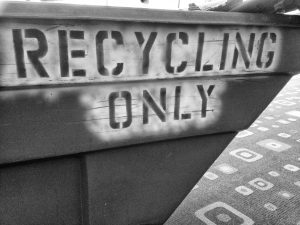The global extinction of species warned of in this year’s One Book, One Chicago selection, The Sixth Extinction, has many of us thinking about how we can help save our climate. One way is by reducing the amount of waste we produce. When products are disposed of, they are either put in landfills, burned or recycled. But even recycling can have a high environmental price as it requires energy and resources. In particular, the use of plastics has far-reaching environmental impacts: 91% aren’t recycled, and plastics are the petroleum products projected to account for 20% of global oil consumption by 2050.
The following articles discuss the zero-waste movement in which people, businesses and governments seek to reduce the amount of trash. You can read these articles using CPL's Online Resources, but I've also noted if an article is available freely on the web.
“Is It Possible to Live Trash-Free?” by Cady Drell
Marie Claire, August 2019 (also available on the Marie Claire website)
The zero-waste movement seeks to reuse or compost everything to create less trash. It’s led by women, the household members more often responsible for buying groceries. The author interviews outspoken practitioners of the zero-waste lifestyle like Bea Johnson and Anne-Marie Bonneau. She also gives it a try herself, buying bulk from a food co-op to avoid packaging, bringing reusable dishware to work and ordering less takeout in favor of cooking at home. Drell concludes that although most people won’t go completely trash-free, we can all reduce our trash output considerably by making an effort.
“Zero Waste Lifestyle: How One Family Learned to Live with Less” by Eva Botkin-Kowacki
Christian Science Monitor, April 16, 2019 (also available on the Christian Science Monitor website)
Bea Johnson describes how her family achieved a zero-waste lifestyle, producing only one jar of trash per year. The family began the lifestyle for environmental reasons, but discovered it also helped them save money and lead simpler and healthier lives. Johnson talks about the “five R’s” that allow them to live without waste: refuse the things you don’t need (like plastic bags), reduce what you use, reuse items, recycle what you can’t refuse and rot, meaning composting organic materials. Johnson is the author of Zero Waste Home.
“Plastic Bags? No. Empty Water Bottles? Yes. Evanston Officials Looking to Educate Residents on Recycling Practices” by Karen Ann Cullotta
Chicago Tribune, September 6, 2019 (also available on the Chicago Tribune website)
Evanston is working to become a zero-waste city by 2050. Efforts include educating citizens on recycling do's and don'ts. For example, plastic bottles containing liquids will burst and ruin other materials during the recycling process, and plastic bags will clog the machine. The city also provides composting services and incentives for residents to use smaller garbage cans.
"Venders [sic] at Wicker Park Farmer’s Market Shed Plastic...Mostly” by Mitch Dudek
Chicago Sun-Times, June 2, 2019 (also available on the Chicago Sun-Times website)
To reduce the amount of plastic going to landfills, vendors at the Wicker Park farmers market use paper, cardboard and glass to package their wares. Customers are encouraged to bring their own containers, and the market provides free canvas bags they can use for their shopping. Wicker Park's is the first farmers market in Chicago to stop using plastics.
“Ending Food Waste, One Dish at a Time” by Ciara Nugent
Time Magazine, October 1, 2018
This article features acclaimed Swedish chef Paul Svensson, whose restaurant Fotografiska is at the forefront of the zero-waste movement. His plant-based menu uses seasonal produce and seeks to either use or compost all the ingredients. Used wine bottles are sent to an artisan who makes them into glasses and vases. Svensson hopes to inspire diners to adopt zero-waste practices at home. Svensson is recognized in the Culinary Institute of America’s Plant-Forward Global 50 list.




Add a comment to: Waste Not: 5 Articles on the Zero-Waste Movement